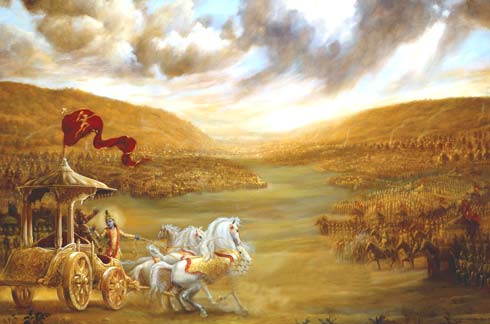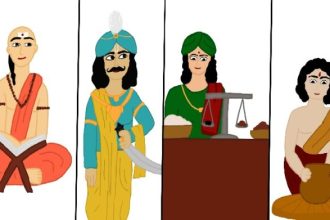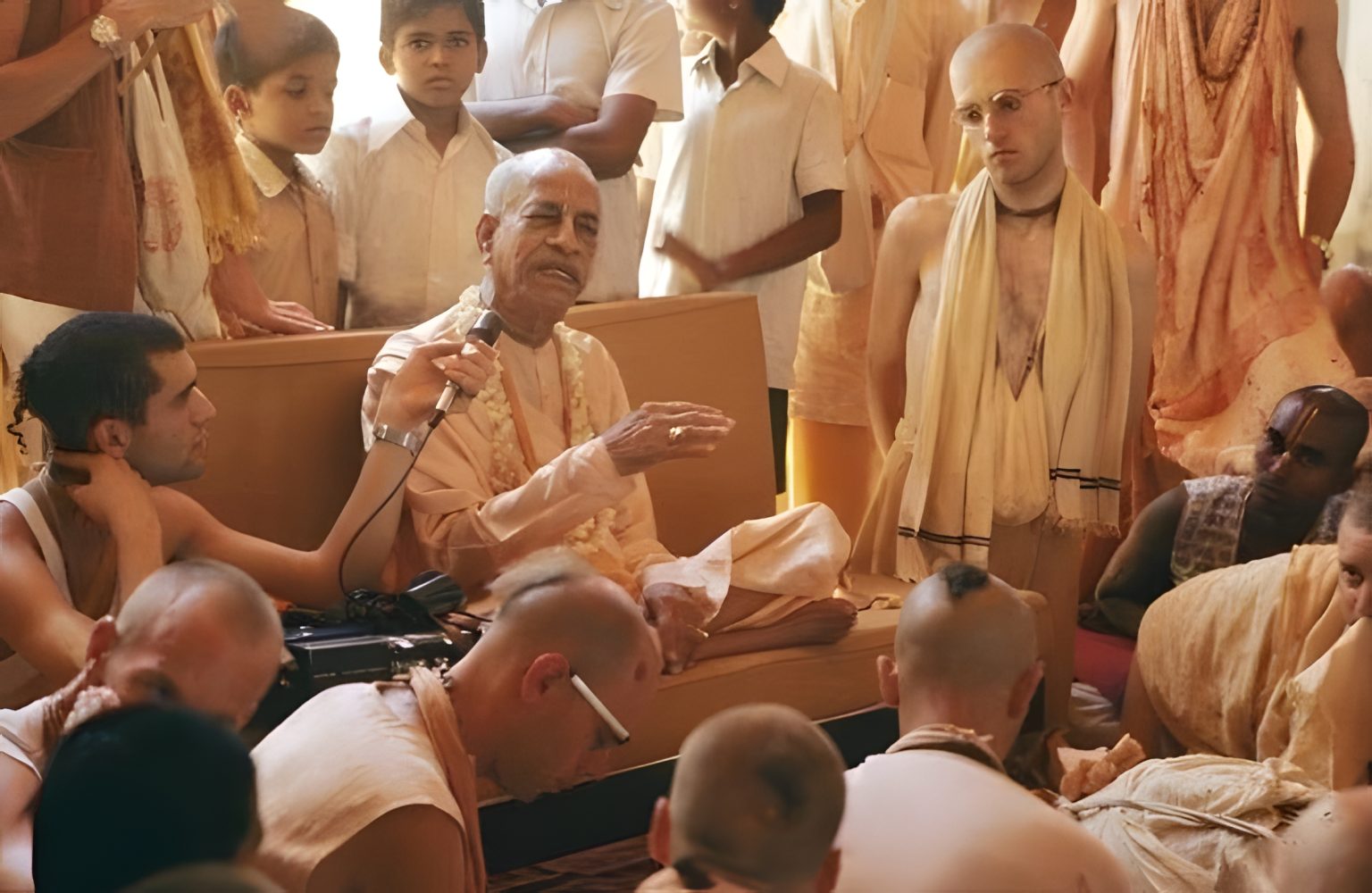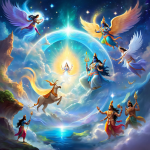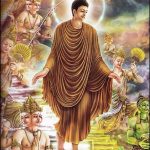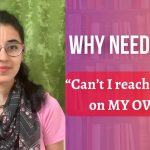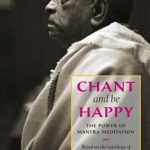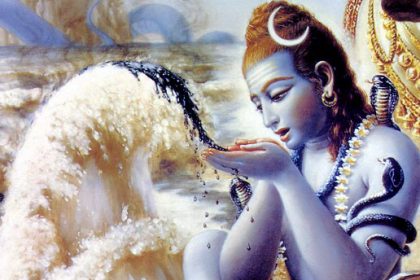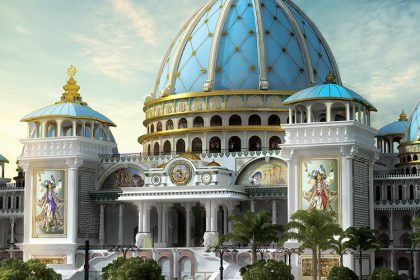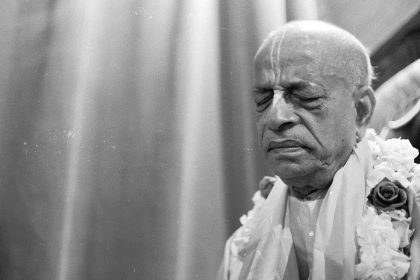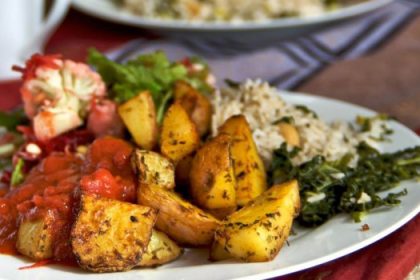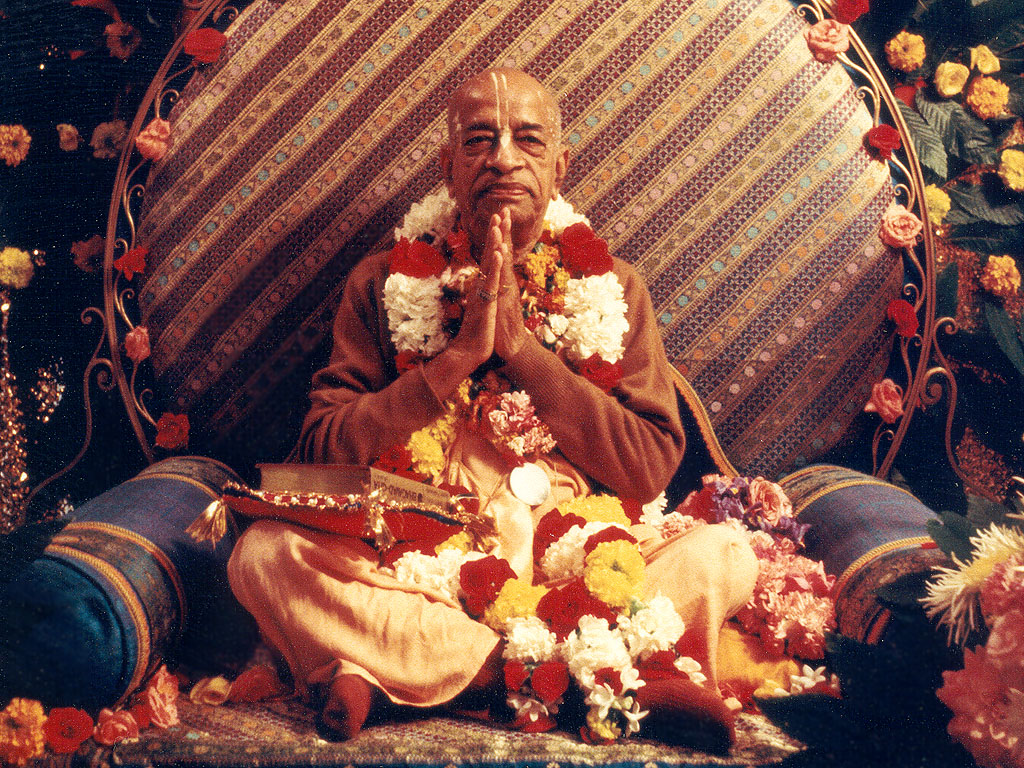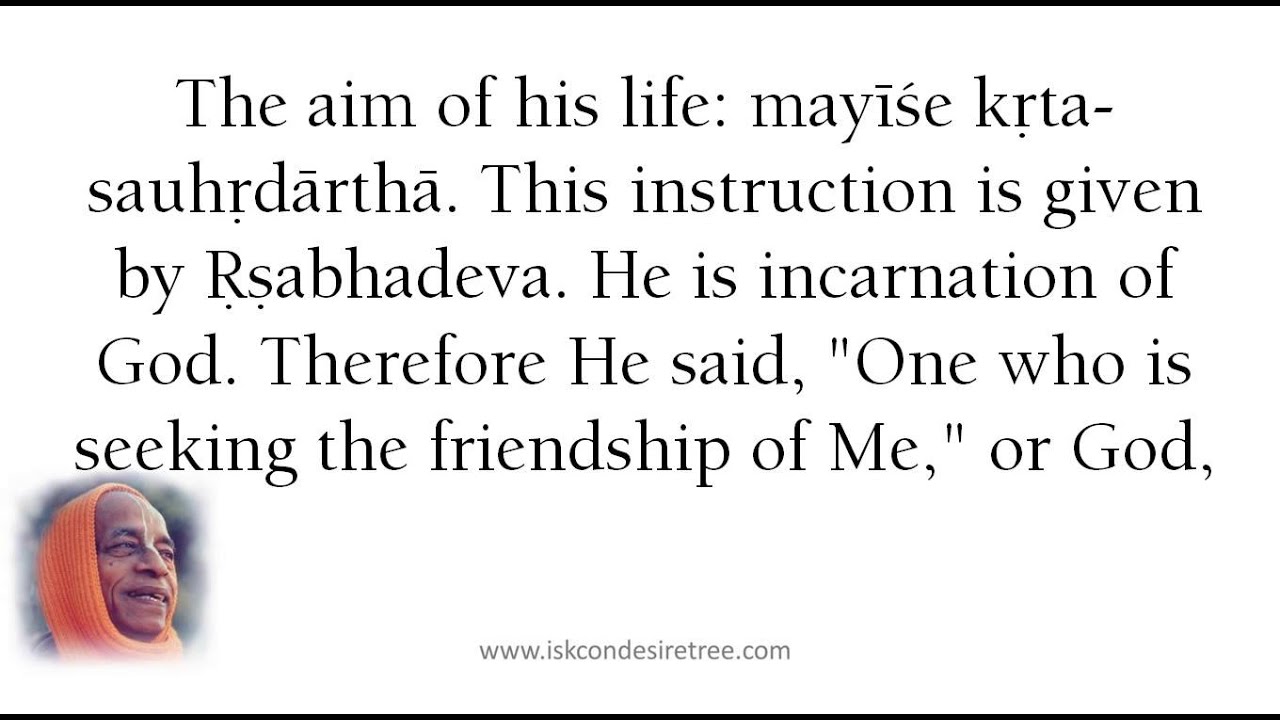An address given at the University of Stockholm in September of 1973 by His Divine Grace A.C. Bhaktivedanta Swami Prabhupāda.
In order to enter into spiritual life, two things are required. As enunciated by Śrī Caitanya Mahāprabhu, one needs the mercy of the Supreme Lord and the mercy of the spiritual master:
brahmāṇḍa bhramite kona bhāgyavān jīva
guru-kṛṣṇa-prasāde pāya bhakti-latā-bīja
The living entities are wandering throughout the universe changing bodies, transmigrating from one body to another, from one place to another, and from one planet to another. Brahmāṇḍa bhramite: they are rotating within this material universe. This science is unknown to the modern educators-how the spirit soul is transmigrating from one body to another, and how he is being transferred from one planet to another. But we have explained this in our book Easy Journey to Other Planets.
In fact, the guru can help you transmigrate from this planet directly to the spiritual sky, Vaikuṇṭhaloka, where there are innumerable spiritual planets. The topmost planet in the spiritual sky is Kṛṣṇa’s planet, called Goloka Vṛndāvana. The Kṛṣṇa consciousness movement is trying to give information of how one can be transferred directly to the Goloka Vṛndāvana planet, Kṛṣṇaloka. That is our mission.
What is the difference between this material world and the spiritual world? The difference is that in the material world you have to change your body, although you are eternal. ajo nityaḥ śāśvato ’yaṁ purāṇo na hanyate hanyamāne śarīre
You are not destroyed after the annihilation of your material body, but you transmigrate to another body, which may be one of 8,400,000 forms. Jalajā nava-lakṣāṇi. There are 900,000 forms in the water, 2,000,000 forms of trees and plants, 1,100,000 forms of insects, 1,000,000 forms of birds, and 3,000,000 forms of beasts. Then you come to this human form of life. Now it is your choice whether to be transferred again, by the cycle of transmigration, from one body to another in the lower species of life, or whether to be transferred to the spiritual sky—to the highest spiritual planet, known as Goloka Vṛndāvana. That is your choice. You have been given the chance of this human form of body to make your choice. In the lower species you are completely under the control of material nature, but when the material nature gives you a chance to get the human form of body, you can choose whatever you like.
That is confirmed in the Bhagavad-gītā (9.25):
yānti deva-vratā devān
pitṝn yānti pitṛ-vratāḥ
bhūtāni yānti bhūtejyā
yānti mad-yājino ’pi mām
Those who are trying to be elevated to the higher planets—deva-loka, or the planets of the demigods, where the standard of living and the life span are very great—may worship the demigods. Or you want you may be transferred to the Pitrloka, to the planets of the ghosts, to the planet where Kṛṣṇa lives (yānti mad-yājino ’pi mām). This all depends on your activities. But saṁsāra—rotating, wandering within this material world from one body to another or from one planet to another—is not advised. Material existence is called saṁsāra. Bhūtvā bhūtvā pralīyate: you take your birth in some form of body, you live for some time, then you have to give up this body. Then you have to accept another body, again live for some time, then go up that body, and then again accept another body. This is called saṁsāra.
The material world is compared dāvānala, a forest fire. As we have experienced, no one goes to the forest set a fire, but still it takes place. Similarly, no one within this material world wants to be unhappy. Everyone is trying to be very happy, but one is forced to accept unhappiness. In this material world, from time immemorial to the present moment, there have been occasional wars, world wars, even though people have devised various means to stop wars. When I was a young man there was the League of Nations. In 1920, after the First World War different nations formed the League Nations, just to arrange for peaceful living among themselves. No one wanted war, but again there was a forest fire the Second World War. Now they have devised the United Nations, but war still going on—the Vietnam war, the Pakistan war, and many others. So you may try your best to live very peacefull but nature will not allow you. There must be war. And this warlike feeling always going on, not only between nation and nation, but also between man and man, neighbor and neighbor—even between husband and wife and father and son. This warlike feeling is going on. This is called dāvānala, a forest fire. No one goes to the forest to set fire, but automatically, by the friction of dried bamboo, sparks arise, and the forest catches fire. Similarly, although we do not want unhappiness, by our dealings we create enemies, and there is fighting and war. This is called saṁsāra-dāvānala. This forest fire of material existence goes on perpetually, and the authorized person who can deliver you from this fire is called guru, the spiritual master.
How does he deliver you? What is his means? Consider the same example. When there is a fire in the forest, you cannot send a fire brigade or go there yourself with bucketfuls of water to extinguish it. That is not possible. Then how will it be extinguished? You need water to extinguish fire, but where will the water come from—from your bucket or your fire brigade? No, it must come from the sky. Only when there are torrents of rain from the sky will the blazing forest fire be extinguished. These rains from the sky do not depend on your scientific propaganda or manipulation. They depend on the mercy of the Supreme Lord. So the spiritual master is compared to a cloud. Just as there are torrents of rain from a cloud, so the spiritual master brings mercy from the Supreme Personality of Godhead. A cloud takes water from the sea. It doesn’t have its own water, but takes water from the sea. Similarly, the spiritual master brings mercy from the Supreme Personality of Godhead. Just see the comparison. He has no mercy of his own, but he carries the mercy of the Supreme Personality of Godhead. That is the qualification of the spiritual master.
The spiritual master will never say, “ I am God—I can give you mercy.” No. That is not a spiritual master—that is a bogus pretender. The spiritual master will say, “I am a servant of God; I have brought His mercy. Please take it and be satisfied.” This is the spiritual master’s business. He is just like a mailman. When a mailman delivers you some large amount of money, it is not his own money. The money is sent by someone else, but he honestly delivers it—”Sir, here is your money. Take it.” So you become very much satisfied with him, although it is not his money he is giving you. When you are in need and you get money from your father or someone else—brought by the mailman—you feel very much satisfaction.
Similarly, we are all suffering in this blazing fire of material existence. But the spiritual master brings the message from the Supreme Lord and delivers it to you, and if you kindly accept it, then you’ll be satisfied. This is the business of the spiritual master
saṁsāra-dāvānala-līḍha-loka-
trāṇāya kāruṇya-ghanāghanatvam
prāptasya kalyāṇa-guṇārṇavasya
vande guroḥ śrī-caraṇāravindam
Thus the spiritual master is offered obeisances: “Sir, you have brought mercy from the Supreme Lord; therefore, we are much obliged to you. You have come to deliver us, so we offer our respectful obeisances.” That is the meaning of this verse: the first qualification of the spiritual master, or guru, is that he brings you the message to stop the blazing fire in your heart. This is the test.
Everyone has a blazing fire within his heart—a blazing fire of anxiety. That is the nature of material existence. Always, everyone has anxiety; no one is free from it. Even a small bird has anxiety. If you give the small bird some grains to eat, he’ll eat them, but he won’t eat very peacefully. He’ll look this way and that way—”Is somebody coming to kill me?” This is material existence. Everyone, even a president like Mr. Nixon, is full of anxieties. What to speak of others. Even Gandhi, in our country—he was full of anxiety. All politicians are full of anxiety. They may hold a very exalted post, but still the material disease—anxiety—is there. So if you want to be anxiety-less, then you must take shelter of the guru, the spiritual master. And the test of the guru is that by following his instructions you’ll be free from anxiety. This is the test. Don’t try to find a cheap guru or a fashionable guru. Just as you sometimes keep a dog as a fashion, if you want to keep a guru as a fashion—”I have a guru ”—that will not help. You must accept a guru who can extinguish the blazing fire of anxiety within your heart. That is the first test of the guru.
The second test is, mahāprabhoḥ kīrtana-nṛtya-gīta-vāditra-mādyan-manaso rasena. The second symptom of the guru is that he is always engaged in chanting, glorifying Lord Caitanya Mahāprabhu—that is his business. Mahāprabhoḥ kīrtana-nṛtya-gīta. The spiritual master is dancing and chanting the holy name of the Lord, because that is the remedy for all calamities within this material world.
At the present moment, no one can meditate. The so-called meditation now popular in the West is humbug. It is very difficult to meditate in this disturbing age of Kali [the age of quarrel and hypocrisy]. Therefore śāstra [scripture] says, kṛte yad dhyāyato viṣṇum. In the Satya-yuga [the age of truth], when people used to live for one hundred thousand years, Vālmīki Muni attained perfection by meditating for sixty thousand years. But now we have no guarantee that we are going to live for sixty years or even sixty hours. So meditation is not possible in this age. In the next age [the Treta-yuga], people performed rituals, as they are described in the Vedic śāstra. Tretāyāṁ yajato makhaiḥ.. Makhaiḥ means performing big, big sacrifice. That requires huge amounts of money. In the present age people are very poor so they cannot perform these sacrifices. Dvāpare paricaryāyām—in the Dvāpara-yuga [the age just prior to the present age] it was possible to worship the Diety opulently in the temple, but nowadays in the Kali-yuga, that is also an impossible task. Therefore, the general recommendation is kalau tad dhari-kīrtanāt: in this age of Kali one can attain all perfection simply by chanting the holy names of the Lord. The Kṛṣṇa conscious movement is meant to spread chanting. Śrī Caitanya Mahāprabhu inaugurated this movement of chanting and dancing. It has been going on for last five hundred years. In India it is popular, but in the Western countries have just introduced it five or six years ago. Now people are taking to it they are feeling happy. This is the process.
Therefore, the guru is always engaged in chanting. Mahāprabhoḥ kīrtana-nṛtya-gīta—chanting and dancing. Unless he performs it himself, how can he teach his disciples? So his first symptom is that he will give you such instructions that immediately you will feel relief from all anxiety, and his second symptom he is always personally engaged in chanting the holy name of the Lord and dancing. Mahāprabhoḥ kīrtana-nṛtya-gīta-vāditra-mādyan-manaso rasena: spiritual master enjoys transcendental bliss within his mind by chanting and dancing. Unless you become blissfull, you cannot dance. You cannot dance artificially. When devotees dance, it is not artificial. They feel some transcendetal bliss, and therefore they dance. It is not that they are dancing dogs. No. Their dancing is performed from the spiritual platform. Romāṅca-kampāśru-taraṅga bhājaḥ. There are sometimes transformations of the body with spiritual symptoms—sometimes crying, sometimes the hairs standing on end. There are so many symptoms. These are natural. These symptoms are not imitated, but when one is spiritually advanced, they are visible.
The third symptom of the guru is :
śrī-vigrahārādhana-nitya-nānā-
śṛṅgāra-tan-mandira-mārjanādau
yuktasya bhaktāṁś ca niyuñjato ‘pi
vande guroḥ śrī-caraṇāravindam
The spiritual master’s duty is to engage the disciples in worshiping the Diety, śrī-vigraha. In all of our one hundred centers, we engage in Deity worship. Here in Stockholm this worship has not yet been fully established, but we worship the pictures of Lord Caitanya and the guru. In other centers, such as the ones in England and America, there is Deity worship. śrī-vigrahārādhana-nitya-nānā-śṛṅgāra-tan-mandira-mārjanādau: Deity worship means to dress the Deity very nicely, to cleanse the temple very nicely, to offer nice foodstuffs to the Deity, and to accept the remnants of the Deity’s foodstuffs for our eating. This is the method of Deity worship. Deity worship is done by the guru himself, and he also engages his disciples in that worship. This is the third symptom. The fourth symptom is:
catur-vidha-śrī-bhagavat-prasāda-
svādv-anna-tṛptān hari-bhakta-saṅghān
kṛtvaiva tṛptiṁ bhajataḥ sadaiva
vande guroḥ śrī-caraṇāravindam
The spiritual master encourages distribution of prasāda (remnants of Kṛṣṇa’s foodstuffs) to the public. Ours is not dry philosophy—simply talk and go away. No. We distribute prasāda, very sumptuous prasāda. In every temple, we offer prasāda to anyone who comes. In each and every temple we already have from fifty to two hundred devotees, and outsiders also come and take prasāda. So prasāda distribution is another symptom of the guru.
If you eat bhagavat-prasāda, then gradually you become spiritualized; it has this potency. Therefore it is said that realization of God begins with the tongue. Sevonmukhe hi jihvādau: if you engage your tongue in the service of the Lord, then you realize God. So what is that engagement of the tongue? You chant the holy name of the Lord, and you take this prasāda, remnants of foodstuffs offered to the Lord. Then you become self-realized, God-realized—by these two methods. You don’t have to be very highly educated or be a philosopher, a scientist, or a rich man to realize God. If you just sincerely engage your tongue in the service of the Lord, you will realize Him. It is so simple. It is not very difficult. Therefore the guru, the spiritual master, introduces this prasāda program. Svādv-anna-tṛptān hari-bhakta-saṅghān. Hari-bhakta-saṅghān means “in the association of devotees.” You cannot do it outside. Kṛtvaiva tṛptiṁ bhajataḥ sadaiva: when the guru is fully satisfied that prasāda distribution is going on, he is very much pleased, and he engages himself in the devotional service of the Lord by chanting and dancing. This is the fourth symptom.
The fifth symptom is:
śrī-rādhikā-mādhavayor apāra-
mādhurya-līlā guṇa-rūpa-nāmnām
prati-kṣaṇāsvādana-lolupasya
vande guroḥ śrī-caraṇāravindam
The spiritual master is always thinking of the pastimes of Kṛṣṇa with His consort Śrīmatī Rādhārāṇī and the gopīs. Sometimes he is thinking about Kṛṣṇa’s pastimes with the cowherd boys. This means that he is always thinking of Kṛṣṇa engaged in some kind of pastime. Prati-kṣaṇāsvādana-lolupasya. Prati-kṣaṇa means he is thinking that way twenty-four hours a day. That is Kṛṣṇa consciousness. One must be engaged twenty-four hours a day in thinking of Kṛṣṇa. You have to make yourself a program like this. We, at least, have made such a program—all the boys and girls in the Kṛṣṇa consciousness movement are engaged twenty-four hours daily—not just officially, not that once a week they meditate or go to some temple. No, they engage twenty-four hours a day. The next symptom is:
nikuñja-yūno rati-keli-siddhyai
yā yālibhir yuktir apekṣaṇīyā
tatrāti-dākṣyād ati-vallabhasya
vande guroḥ śrī-caraṇāravindam
The spiritual master’s ultimate goal is that he wants to be transferred to the planet of Kṛṣṇa, where he can associate with the gopīs to help them serve Kṛṣṇa. Some spiritual masters are thinking of becoming assistants to the gopīs, some are thinking of becoming assistants to the cowherd boys, some are thinking of becoming assistants to Nanda and mother Yaśodā, and some are thinking of becoming God’s servants. Some are thinking of becoming flower trees, fruit trees, calves, or cows in Vṛndāvana. There are five kinds of mellows: śānta [veneration], dāsya [servitorship], sakhya [friendship], vātsalya [parenthood], and mādhurya [conjugal love]. Everything is there in the spiritual world. Cintāmaṇi-prakara-sadmasu: in the spiritual sky, even the land is spiritual. The trees are spiritual, the fruit is spiritual, the flowers are spiritual, the water is spiritual, the servants are spiritual, the friends are spiritual, the mothers are spiritual, the fathers are spiritual, the Lord is spiritual, and His associates are spiritual. It is all absolute, although there are varieties.
In the material world these spiritual varieties are merely reflected, just like trees on a riverbank. A tree is reflected in the water, but reflected how? Upside down. Similarly, this material world is a reflection of the spiritual world, but a perverted reflection. In the spiritual world there is love between Rādhā and Kṛṣṇa. Kṛṣṇa is always young—nava-yauvana. And Rādhārāṇī is always young, because She is Kṛṣṇa’s pleasure potency.
Śrī-rādhikā-mādhavayor apāra. Jaya rādhā-mādhava. We worship not Kṛṣṇa alone but Kṛṣṇa with His eternal consort Śrīmatī Rādhārāṇī. There is eternal love between Rādhārāṇī and Kṛṣṇa. Therefore the Vedānta-sūtra says, janmādy asya yataḥ: the Absolute Truth is that from which everything emanates. In this world we find love between mother and son, love between wife and husband, love between master and servant, between friend and friend, between the master and the dog or the cat or the cow. But these are only reflections of the spiritual world. Kṛṣṇa is also the good lover of the animals, the calves and cows. Just as here we love dogs and cats, there Kṛṣṇa loves cows and calves. You have seen this in pictures of Kṛṣṇa. So the propensity to love even an animal is there in the spiritual world. Otherwise, how can it be reflected? This world is simply a reflection. If in the reality there is nothing like that, how can it be reflected here? So everything is there in the spiritual world. But to understand that original propensity to love, you have to practice Kṛṣṇa consciousness.
Here in this world we are experiencing frustration. Here we love—a man loves a woman, or a woman loves a man—but there is frustration. After some time they are divorced, because their love is a perverted reflection. There is no real love in this world. It is simply lust. Real love is in the spiritual world, between Rādhā and Kṛṣṇa. Real love is there between Kṛṣṇa and the gopīs. Real love is there in the friendship between Kṛṣṇa and His cowherd boys. Real love is there between Kṛṣṇa and the cows and calves. Real love is there between the trees, flowers, and water. In the spiritual world, everything is love. But within this material world, we are satisfied merely by the reflection of the things in the spiritual world. So, now that we have this opportunity of human life, let us understand Kṛṣṇa. That is Kṛṣṇa consciousness—let us understand Kṛṣṇa. And as the Bhagavad-gītā [4.9] says, janma karma ca me divyam evaṁ yo vetti tattvataḥ—you should understand Kṛṣṇa in truth, not superficially. Learn the science of Kṛṣṇa. This is the instruction—you should simply try to love Kṛṣṇa. The process is that you worship the Deity, you take prasāda, you chant Kṛṣṇa’s holy names, and you follow the instruction of the spiritual master. In this way you’ll learn how to understand Kṛṣṇa, and then your life will be successful. This is our Kṛṣṇa consciousness movement. Thank you very much.


